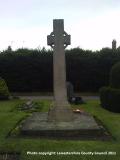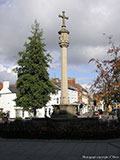Private Herbert William Granger, 235121
- Batt - 1
- Unit - South Staffordshire Regiment
- Section -
- Date of Birth - 1891
- Died - 26/10/1917
- Age - 25
Add to this record?
If you have photographs, documents or information that can contribute to this record, you can upload here
ContributeSource: Michael Doyle Their Name Liveth For Evermore: The Great War Roll of Honour for Leicestershire and Rutland. He was the son of Joseph Granger, a signalman, born 1857 in Northamptonshire and his wife Sarah Ann Granger (nee Clifford, married in the 2nd quarter of 1883 in the Market Harborough, Leicestershire district), born 1857 in East Farndon, Northamptonshire. Herbert William was born in the 3rd quarter of 1891 in Hallaton, Leicestershire, his siblings were, Francis Joseph, born 1889 in Somerby, Leicestershire, Leonard George, born 1893 and Edward James, born 1896 the latter two siblings were both born in Little Bowden, Northamptonshire, in April 1901 the family home was at 68, Stanley Street, Kingsthorpe, Northamptonshire. In April 1911 Herbert was employed as a railway porter and was residing in the family home at 5, York Street, Great Bowden, Leics., together with his wife Hilda Granger (nee Tebbutt, married in the 3rd quarter of 1910 in the Market Harborough, Leicestershire district), born 1877 in Leicester and their daughter Ivy, born 1911 in Market Harborough, Leicestershire. His elder brother John Robert Clifford was lost at sea.
The War Diary for the 26th October 1917 records. The Battalion took part in the operations at GHELUVELT (See “Narrative of Operations, 26th October 1917”) attached.
The following casualties occurred:- Officers, 2nd Lt. (Acting Captain) W. H. CURRY killed in action 25/10/17. 2nd Lt. R. S. PULLEN killed in action 26/10/17. 2nd Lt. D. S. GLAZE killed in action 26.10.17. 2nd Lt. G. A. C. SHEFFIELD killed in action 26/10/17. 2nd Lt. V. HIELD killed in action 26/10/17. 2nd Lt. W. H. NOKES killed in action 26/10/17. 2nd Lt. S. H. HOULE wounded 26/10/17. 2nd Lt. H. E. POULTON wounded and missing 26/10/17. Other ranks, killed 38, wounded, 136, missing, 91. See letter of appreciation from Major General T. R. SHOUBRIDGE, C.M.G., D.S.O. attached.
NARRATIVE OF OPERATIONS 26th OCTOBER 1917
1. The forming up went off without incident, in spite of a very bright moon. There was a little shelling about 3.00am but only a few casualties were caused.
2. At zero the advance began. Heavy machine gun fire immediately opened up on our lines, and a medium barrage came down along the whole ridge, being somewhat severe about Battalion HQ.
3. “C” Company on the left made progress in spite of heavy casualties from machine gun fire until within about 150 yards
of BERRY – COTTS. Here very strong opposition was met with. Stick bombs were freely used by the enemy and the attack was swept by machine gun fire from BERRY – COTTS and LEWIS HOUSE. The mud had by now rendered most of the rifles and Lewis guns useless, and the Company strength was about 1 officer, and 20 other ranks. No further progress could be made and the remains of the Company lay in shell holes until an opportunity could be found by retiring to the original front line.
4. “D” Company in the centre met with very strong opposition from HAMP FARM and suffered heavy casualties from cross machine gun fire. They could make no progress after advancing about 50 yards in front of our original front line.
4. “B” Company on the right suffered less from machine gun fire than the other Companies, being protected to a certain extent by lie of the ground. In consequence, they were able to make a determined attack on their objective THE MOUND, which is a more important feature in the ground than would be imagined from the map. THE MOUND was strongly held by the enemy, and heavy fighting ensued. After a prolonged and desperate struggle, during which both officers and all the senior NCO’s were killed or wounded, “B” Company now under the command of a Corporal carried their objective. The enemy retired, leaving many dead and a heavy machine gun behind them. The position was consolidated, and messages sent back for reinforcements. Unfortunately, all the runners sent back became casualties, and no message reached Battalion HQ. During the afternoon our artillery persistently shelled this position, and owing to their isolation the remnants of “B” Company were compelled to fall back at dusk. The captured machine gun was destroyed before the position was evacuated.
5. By dusk, what was left of the Battalion was back on the original front line and was reorganised as far as possible.
6. The Battalion was relieved by 11.00pm by the 20th Battalion MANCHESTER REGT. The relief passed off quietly.
(Signed) A. B. Beauman Lt. Colonel Commanding 1st Battalion South Staffordshire Regt. 31/10/17
COPY OF LETTER FROM MAJOR GENERAL T. R. SHOUBRIDGE C.M.G., D.S.O., COMMANDING 7th DIVISION
Dear Beauman,
I have just seen the Army Commander. Though he regrets we did not get our objective as much as we do ourselves, he fully realises that officers and men did all that was humanly possible in the face of great difficulties.
He also told me that the enemy had a railway reserve between MENIN and PASSCHENDAELE intending to employ it at the most threatened point. Our attack showed such determination that he retained all reserves opposite us. This helped the Canadians materially to gain and hold their objectives. Therefore we did not fight in vain.
The 7th Division has taken hard knocks before, but it never loses its splendid spirit, and yesterdays battles will only be incentive to get our own back on the next opportunity.
Will you convey the contents of this letter to all officers, NCO’s and men, and also tell them how proud I am of the way in which they went forward under the worst conditions of mud and fire and would not give in until they died or stuck in the mud. No soldiers can do more.
Yours Sincerely
(Signed) Herbert Shoubridge
Source: Leicestershire War Memorials Project. Although Herbert was born in Hallaton he only lived here for a couple of years as an infant, as his father who worked for the Midland Railway Company was moved around to different stations. The first move of his life was to Kingsthorpe, Northampton were they were living at the time of the 1901 census. After leaving school Herbert also worked for the railway company as a porter at Market Harborough Station. He married young, aged only 19 to a Hilda Tebbutt who worked as a corset maker at R & WH Symington Ltd, the biggest employer in the town. A daughter Ivy was born in March 1911 followed by Herbert E in 1912. At some time after this the family moved to Coalville where Herbert worked in a brickyard. Another daughter Constance Hilda was born in February 1915. His military papers have not survived but it is probable he was called up in January 1917, firstly into the Leicestershire Regiment but after initial training was posted to the 1st Battalion South Staffordshire Regiment with service number 235117, most likely as part of a draft to make up for serious losses. 1st Bn South Staffs. were at that time involved in bloody episodes of what became known as the Third Battle of Ypres, initially in the latter stages in the attack on Polygon Wood from 26th September to 4th October. The weather was absolutely frightful. Continuous bombardment had totally destroyed all the drainage systems in this low lying land and rain had turned the area into a mud bath where a slip off a duck board meant probable death by drowning. The state is illustrated by this image. It had been decided that it was essential to capture the high ground east of Ypres which was being used by the Germans to dominate the adjacent plateau. 1st South Staffs. were ordered to attack Gheluvelt. This was a major attack planned for 26th October 1917 with fully co-ordinated artillery barrages timed to move forward just ahead of the advancing troops at the rate of 100 yards in six minutes. The attack was launched at 03.00am under a very bright moon. The enemy machine gunfire was devastating and was supplemented by a heavy German barrage all along the ridge. The glutinous mud had rendered most rifles and Lewis guns totally useless. As had so frequently happened in past attacks, the British barrage had failed to destroy the extremely strong German concrete pill boxes. German machine gunners simply kept down during the barrage and as soon as it ceased for fear of hitting British troops, they emerged again. The Battalion suffered fearful losses – over 50% killed, wounded or missing. Private Herbert Granger was among them. His body was never recovered and he is commemorated Hallaton War Memorial and on Tyne Cot Memorial.
Information (including photograph) kindly provided by Dennis Kenyon.
- Conflict - World War I
- Cause of death - KILLED IN ACTION
- Birth Place - Hallaton
- Unit - South Staffordshire Regiment
- Former Unit n.o - 203326
- Former Unit - Leicestershire Regiment
- Cause of death - KILLED IN ACTION
- Burial Commemoration - Tyne Cot Mem., Zonnebeke, West Vlaanderen, Belgium
- Born - Hallaton, Leics
- Enlisted - Coalville, Leics
- Place of Residence - 5 York Street, Great Bowden, Leicestershire, England
- Memorial - MARKET HARBOROUGH MEM., LEICS
- Memorial - COTTAGE HOSPITAL WAR MEM., MARKET HARBOROUGH, LEICS
- Memorial - ST. NICHOLAS'S CHYRD. MEM., LITTLE BOWDEN, NORTHANTS
- Memorial - HALLATON MEM., LEICS




